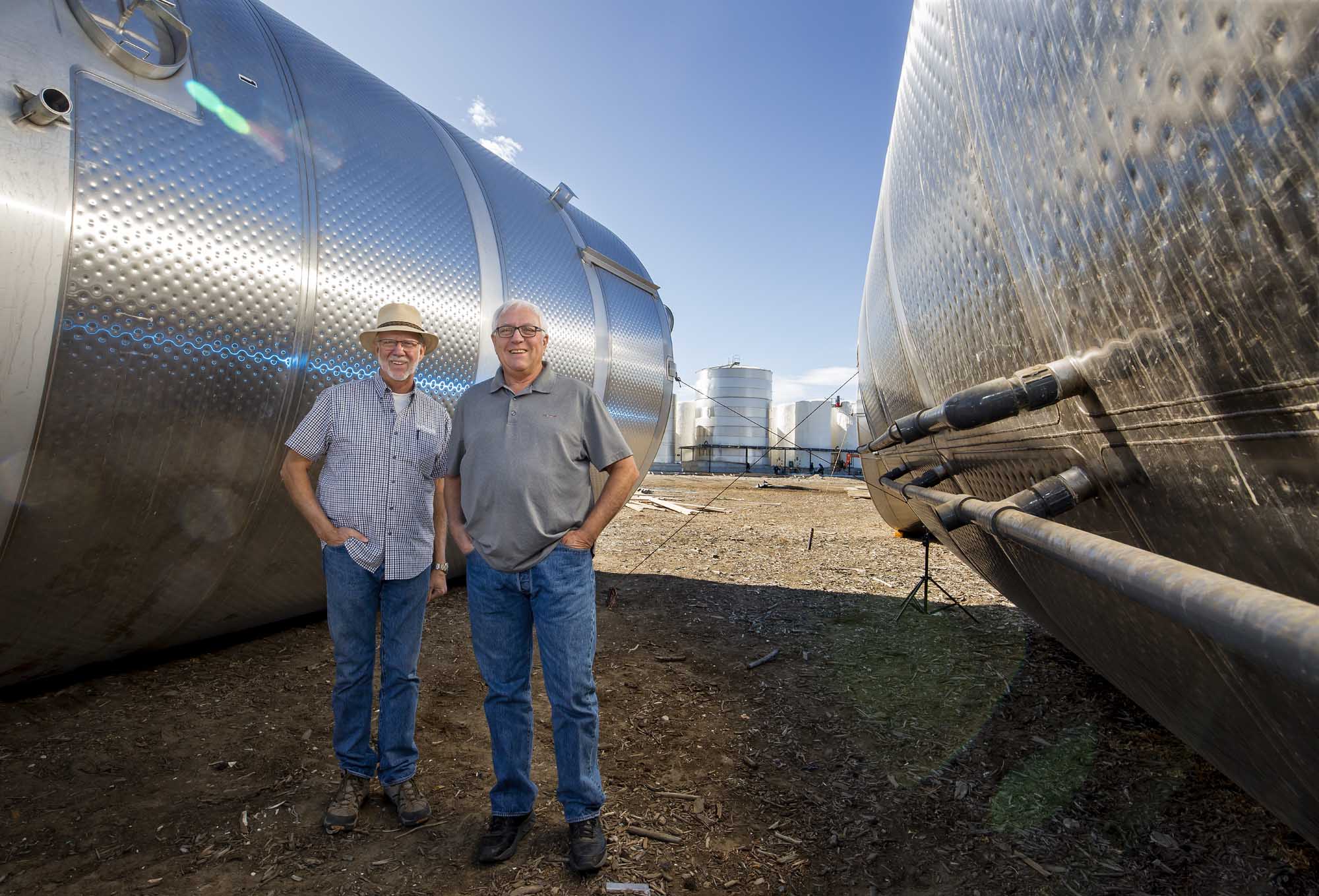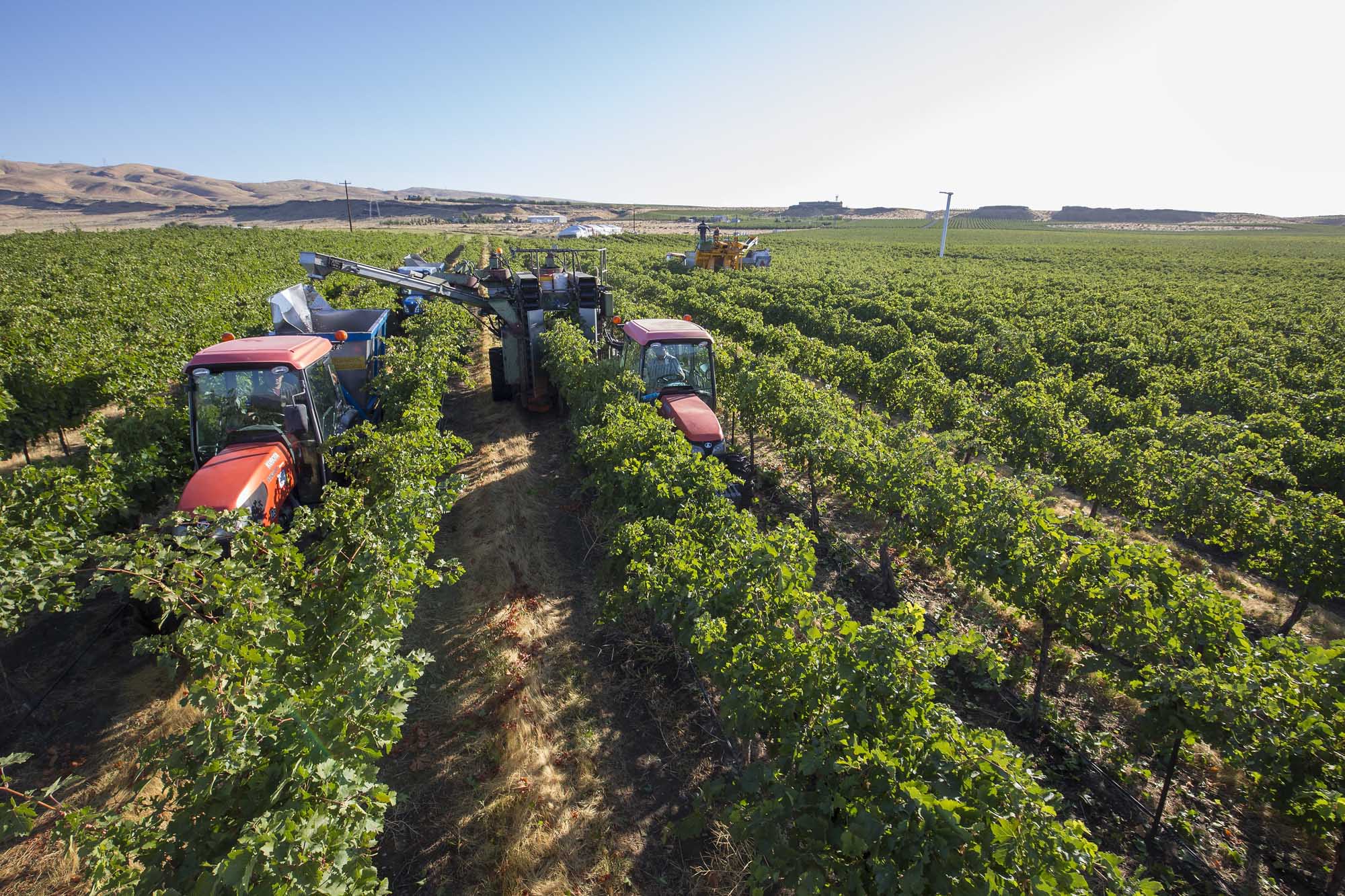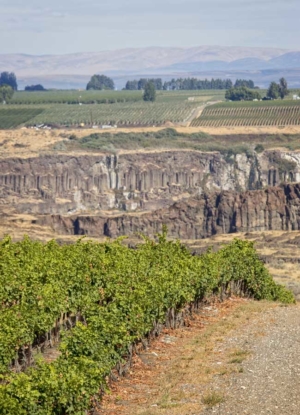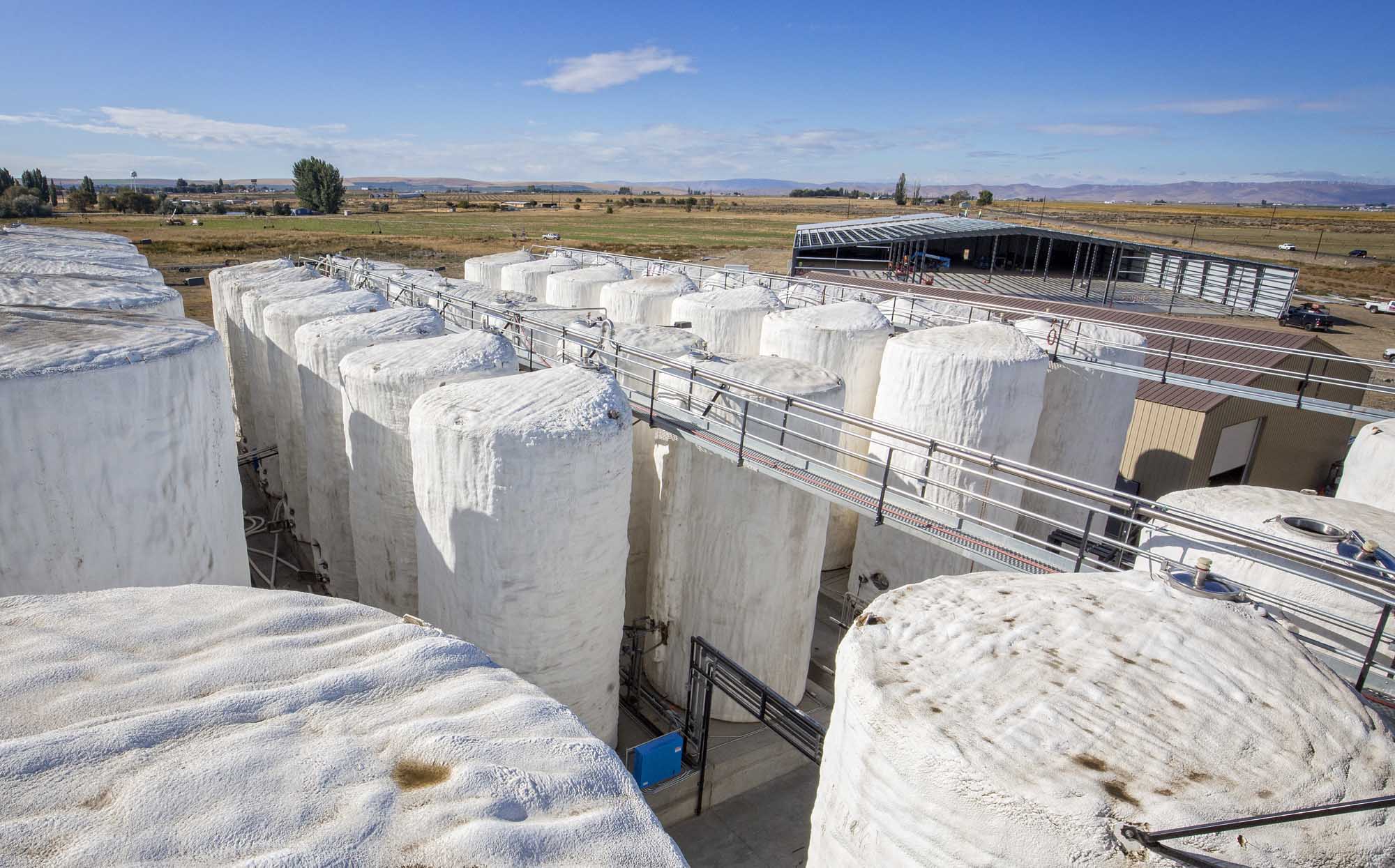
Butch, left, and Jerry Milbrandt stand between two new wine tanks awaiting installation in September 2017 at the Ancient Lake Wine Co. facility in Quincy, Washington. (TJ Mullinax/Good Fruit Grower)
Butch and Jerry Milbrandt, fourth-generation farmers who started in alfalfa and potatoes, planted their first 100 acres of wine grapes in 1997, under contract to Ste. Michelle Wine Estates.
Last year, they celebrated 20 years in the wine industry, and their impact on Washington’s wine industry continues today.
Milbrandt Vineyards has grown to just shy of 3,000 acres and includes several wine labels and two bulk wine facilities — each situated in and named after appellations the Milbrandts helped to champion — with a combined capacity of more than 7 million gallons of wine.
And an expansion at one, Ancient Lake Wine Co. in George, Washington, includes the largest custom wine bottling plant in the state, which began operating in January.
The brothers have divided their focus in recent years, with Butch keeping tabs on the vineyards and bottle sales and Jerry concentrating on the bulk wine side of the business. Both say they’re moving into “semi-retirement.” Neither appears to show any sign of slowing down anytime soon.
“In the beginning, I thought we were going to have 100 acres of grapes,” said Butch, 72, looking at his brother and shaking his head. Jerry, 69, laughed in reply: “Most of the time, I’m happy the way things turned out. Sometimes, I think your way might have been better.”

Two harvesters work in tandem at Milbrandt’s Clifton Hill vineyard north of Mattawa, Washington, in September 2017. Clifton Hill produces three vintages: Cabernet Sauvignon, Syrah and Merlot. (TJ Mullinax/Good Fruit Grower)
But, it all started with the grapes. Overall, the Milbrandts grow some roughly 30 varietals in a dozen orchard sites, most in the Wahluke Slope and Ancient Lakes AVAs.
The Wahluke Slope AVA, established in 2006, lies in a dusty, isolated area of south-central Washington, bordered by the Columbia River, Saddle Mountains and the Hanford Reach National Monument. It is routinely one of the warmest regions in the state and is known for red grape varieties that produce ripe, full-bodied wines.

The soil at Milbrandt’s Evergreen Vineyard near Quincy, Washington, is noted for its unusually high amount of calcium deposits. (TJ Mullinax/Good Fruit Grower)
What sets it apart: consistent soils and climate across the AVA. The entire appellation sits on a broad, 13-mile-wide gravel bar, formed by the Ice Age floods, with a south-facing slope and gentle grade that helps minimize frost risk. Elevations vary between 425 feet by the Columbia River to 1,480 feet above sea level — high elevation sites with ancient soils deposited by the floods.
Wahluke Slope Wine Co., one of the bulk wine facilities, sits on the edge of the AVA overlooking the river in Mattawa, Washington.
The second sits in the Ancient Lakes AVA, recognized in 2012. Elevation ranges from 570 feet at the edge of the Columbia River to more than 1,900 feet in the southern edge, and the region receives very little rainfall — only about 6 inches a year.
The resulting soils, Aridisols that are formed in arid conditions and contain little organic matter, are perfect for wine grapes. The region is known for whites.
Most Milbrandt plantings are on 8-foot centers with 6 feet between bilateral cordon vines, with a standard V-trellis and vertical catchwire system.
Butch Milbrandt and Ryan Flanagan, vineyard operator for Milbrandt’s Evergreen Vineyard in the Ancient Lakes AVA, gave a rundown of a few of their vineyard sites on the Wahluke Slope and in the Ancient Lakes, and what they’ve learned.
The beauty of the Wahluke Slope is the frost-free days, Milbrandt said. “Some of the upper vineyards have as many as 210 frost-free days. It makes a great growing climate,” he said. “Most years, it’s probably the warmest site in the state.”
Pheasant Vineyard was an apple orchard that was converted to grapes. Its alluvial soil in the foothills of the Saddle Mountains in the Wahluke Slope is well drained, which means he has to pay close attention to irrigation, Milbrandt said. “The water just goes right by,” he said. “It requires more frequent irrigation than the vineyards higher up on the ancient soils and more careful overview of the irrigation and fertilization than those vineyards.” The site is known for its Cabernet Sauvignon, Merlot and Syrah, though there is some Riesling planted there as well.
Downslope from Pheasant Vineyard, fine sand atop heavier, coarser gravel comprises the soil at Ravenscliff Vineyards, two distinct sites at 800 and 1,000 feet and overall one of the warmer locations in the Wahluke Slope. That’s why it’s home to Cabernet, Merlot, Grenache, Mouvedre, Malbec and Syrah.

Milbrandt’s Evergreen Vineyard, with the Ancient Lake vineyard across the canyon near Quincy, Washington, on September 18, 2017. (TJ Mullinax/Good Fruit Grower)
Evergreen Vineyard, meanwhile, in the Ancient Lakes AVA is known for whites: Riesling, Chardonnay, Pinot Gris and Sauvignon Blanc. Caliche soils are the main feature there, Flanagan said. “But it’s all fractured, so once those vines get established, they root into it,” he said. However, frost is an ongoing concern, given that the site sits on a ridge. In addition, the variation in topography requires careful irrigation management. “Shorter sets, more consistent, variable drip hose with different rates — just trying to manage the water for each different spot in the vineyard,” he said.
Most of Milbrandt’s plantings have been in for 20 years. If it’s a new site, varieties are planted in five or 10-year blocks to determine what best matches the soil and microclimate, Milbrandt said. If it’s not, “we can always top-graft it over or plant something else.”
Anyone who is going to be in the wine grape industry needs to be educated, have good field people who monitor what’s going on — whether it’s their own field people or from a winery or chemical company. “There needs to be several sets of eyes,” he said.
As longtime grape grower Bill Powers once said, “When you go into a vineyard, what you’re really looking for is the tracks on the ground of the grower, so you know he’s been there and paying attention to the crop,” Milbrandt said. “That’s farming.” •
—by Shannon Dininny

Ancient Lake Wine Co.’s new bottling facility is seen in the distance from the top of their 139 wine storage tanks in Mattawa, Washington, on September 18, 2017. (TJ Mullinax/Good Fruit Grower)






Are they using Paulson1103 rootstocks for their vines?